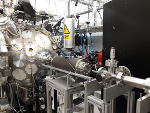| 3 | | **ZOOM:** https://cern.zoom.us/j/64833782572?pwd=UFMyV1FtdnlyVUJycEYzSmgxQkYxZz09 |
| | 3 | == Notes == |
| | 4 | {{{#!comment |
| | 5 | #!html |
| | 6 | <p style="text-align: right"> |
| | 7 | JM 06/10/2021 |
| | 8 | </p> |
| | 9 | }}} |
| | 10 | |
| | 11 | **Present:** Jeff Bamber, Ben Cox, Jamie Guggenheim, Emma Harris, Ken Long, John Matheson, Colin Whyte |
| | 12 | |
| | 13 | __// Discussion: //__ |
| | 14 | A new time for this meeting, or the continuation of the existing slot, will be sorted via Doodle. |
| | 15 | |
| | 16 | EH had produced a draft outline of the Work Package, with milestones and timelines, as a basis for developing the Proposal further. |
| | 17 | |
| | 18 | There was some discussion about the validation of the modelling against experimental data. Data on directionality and frequency response of a given transducer is available from the manufacturer (Imasonic) and this can be included in the k-Wave simulations. We could additionally run experiments to check the manufacturer’s data. The unknown step is the transition from the GEANT simulation to the k-Wave simulation, which may require the introduction of a scaling factor. |
| | 19 | |
| | 20 | EH commented that visits to (a) beamline(s) had been included in the 2 year timescale, to validate the combination of GEANT4 and k-Wave in the computational model. 2 or 3 visits to a beam looks sensible on a 2 year timescale. Once simulation and validation of a test beam is achieved, simulation of the whole LhARA setup should be possible with confidence. Sample holders will have their own impact on the incoming low energy beam and on the acoustic response so should be part of the programme. |
| | 21 | |
| | 22 | Laser photoacoustic measurements in the lab could also provide some level of validation of the simulations. |
| | 23 | |
| | 24 | It was questioned whether it would be better to buy DAQ from industry – such an option could be DAQ from Verasonics with preamplifiers from Aspectus. Alternatively, these might be developments that could be done in-house by RAL. https://verasonics.com/, https://aspectus-gmbh.com/ |
| | 25 | |
| | 26 | There was some question whether the Verasonics frequency response is adequate for our needs. Standard model 500kHz – 20MHz. Extended response versions are available (but not at both ends of the scale simultaneously). Ken’s simulations showed that the Bragg peak longitudinal dimensions were consistent with an upper limit of 20MHz. Microbeams need consideration. |
| | 27 | |
| | 28 | For testing, low energy beams such as Birmingham will be relevant to in vitro but not in vivo applications. The best chance for higher energies would be to collaborate with AVO, using phantoms etc. First in vitro experiments at LhARA would be at the 5 year point. The Birmingham beam needs to be chopped to give us the necessary pulse structure – expensive. |
| | 29 | |
| | 30 | **Actions:** |
| | 31 | * **KL** – circulate Doodle |
| | 32 | - **Done.** |
| | 33 | * **JG** – talk to Tony Price – any progress on contacts with AVO ? |
| | 34 | * **EH, JG, JM** - look through the draft proposal together. |
| | 35 | * **All** – what kit might we ask for from: https://www.ukri.org/opportunity/early-technology-development-and-equipment-for-stfc-grant-holders/ Closing date 27th Oct |
| | 36 | |
